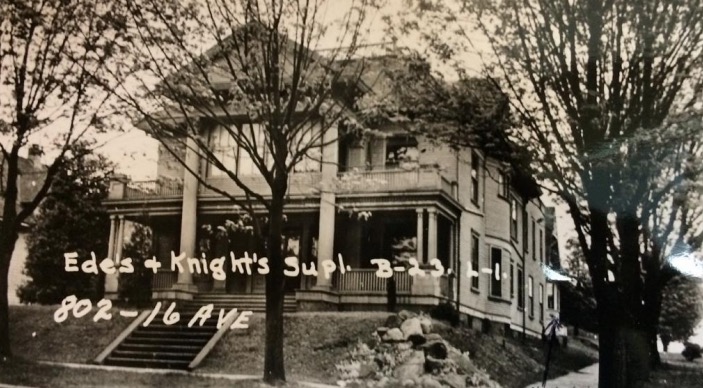People in Preservation | A Look Behind a Landmark Nomination
If you’re reading this, you’re probably somewhat familiar with the City Landmarks Preservation Ordinance. You may know that landmarking is generally a two-part process. The first step is nomination; then, if a nomination meets certain criteria and receives enough votes, it goes on to be considered for designation.
What are those “certain criteria” for landmarking? Does a place need to be super old and really fancy to qualify?
A place does not necessarily need to possess remarkable architecture to qualify as a city landmark. What it does require is to: 1) be over 25 years old, 2) possess integrity or the ability to convey its significance, and 3) meet at least one of the six criteria for designation outlined in the Seattle Landmarks Preservation Ordinance.
Ok, how are landmark nominations initiated?
Nominations come from a variety of sources, including preservation consultants, organizations like Historic Seattle, property owners and citizen advocates. They can also be a requirement triggered by a permit application. In this post, we highlight an example of a recent nomination submitted by a novice citizen advocate on behalf of the property owner.

The Considine House Nomination
The Considine House (also known as the Cohen House and the Immaculate Conception Convent) at 802 16th Ave in the Central District was unanimously nominated by the Landmarks Preservation Board on January 20. Like many of Seattle’s grand old homes, this Neoclassical style residence has lived many lives — first as the home of the Considine family, who played a part in Seattle’s early theater and vaudeville history. Later, it served as a convent for the nearby Immaculate Conception Church. Finally, it was divided into 4 apartments, one of which now serves as the home of its current owner. The nomination report noted that the property “has borne witness to almost 120 years of social and cultural evolution in the heart of Seattle’s Central District…[and] has served as a reflection of the diverse and ever-changing neighborhood.”
Sarah Greiner, who authored the Considine House nomination, grew up less than a mile away. Her partner is the granddaughter of the house’s current owner, artist Sue Perry, whose artwork often reflects the rapidly changing Central District neighborhood. Sue and her daughter Amy Hagopian currently reside in two of the four units that comprise the Considine House today. With extra time on her hands while between jobs, Sarah took on the task of preparing the landmark nomination on behalf of Sue and Amy.
 Amy Hagopian arrived in Seattle in 1972 to attend UW as an undergraduate and has lived all over Seattle in the years since. In the late 1980s, her mother and stepfather decided to relocate to Seattle from Boston and enlisted Amy to help them find a house.
Amy Hagopian arrived in Seattle in 1972 to attend UW as an undergraduate and has lived all over Seattle in the years since. In the late 1980s, her mother and stepfather decided to relocate to Seattle from Boston and enlisted Amy to help them find a house.
“ The first weekend I set out looking, I was shown the Considine House and I immediately told the realtor my folks would take it — sight unseen,” said Amy. “My folks were a retiring faculty member and a social worker, so they didn’t have a ton of money. The fact that it was a multiplex and could produce some necessary income, coupled with the historic nature of the house and that it would be a bit of a project, all made it the perfect place.”
The first weekend I set out looking, I was shown the Considine House and I immediately told the realtor my folks would take it — sight unseen,” said Amy. “My folks were a retiring faculty member and a social worker, so they didn’t have a ton of money. The fact that it was a multiplex and could produce some necessary income, coupled with the historic nature of the house and that it would be a bit of a project, all made it the perfect place.”
The personal connections Sue, Amy, and Sarah all have to the Considine House aren’t solely what inspired them to seek landmarking for the Considine House.
“It is very much a socially significant place,” explained Sarah. “The history of the Considine House truly reflects the changing demographic of the neighborhood, and everyone I talked to when I was doing research was excited that to learn that it might get recognition that would help preserve it.”

Even a long period of vacancy at the Considine House tells an important part of the story, not just of the House, but of Seattle too. Prior to the purchase by Sue and John Perry and following the time it served as a convent, the house sat unoccupied for 6 years. Redlining — a policy imposed in 1960s by White legislators — made securing loans and buying property nearly impossible for Black people, Native Americans, Asian Americans, Pacific Islanders, people of Mexican ancestry, and Jews. Because of this restrictive policy, the Considine House sat unoccupied for six years between serving as a convent and finally being purchased by Sue and John Perry.
“Redlining is such an important historic factor in how this house came to be the way it is,” Amy commented.

The Buford family home in August 2018, now demolished.
“As this neighborhood changes it becomes more and more important to hold on to some of the original components of this community and what mattered here,” said Amy. “It was heartbreaking when the Buford’s home was torn down just to the north of us.” Amy continued, “They got swindled out of their house by developers, which is what’s going on all over the Central District now. For me, watching developers attempt to swoop in take over the neighborhood has a lot to do with wanting to protect this house.” You can read more about the Bufords and their ties to the Considine House and significance in Seattle’s legendary jazz history in the nomination.

Despite multi-generational ties to the neighborhood, Sarah and the Hagopian and Perry families acknowledge their part in the process of gentrification. “I definitely feel complicated in my relationship to the neighborhood,” said Sarah. “When my parents bought their house in the late ‘80s, they were the first White people on the block. The block, and of course the neighborhood, looked very different then than it does now. The Hagopian and Perry family is also mostly White and despite their activism, social awareness, and caring for all their neighbors, they are still a White presence in the neighborhood. I think we can preserve elements of the neighborhood, such as the house, while acknowledging the damage that people including our families and our friends have done. As the nomination report describes, over time the House has been mostly a residence for working class people, and it continues to be one of the only affordable rentals within a few blocks. Not wanting to see more people displaced is a big part of why we are seeking to preserve it. I want to see it continue to be a family space, a gathering space, and a place people can afford to live in.”
 The designation hearing for the Considine House will be held on March 17 at 3:30 pm. Read the nomination report to learn more. We encourage you to support designation through written comments or verbal public testimony at the meeting. Send comments to the Landmarks Preservation Board Coordinator Erin Doherty by March 15 ([email protected]).
The designation hearing for the Considine House will be held on March 17 at 3:30 pm. Read the nomination report to learn more. We encourage you to support designation through written comments or verbal public testimony at the meeting. Send comments to the Landmarks Preservation Board Coordinator Erin Doherty by March 15 ([email protected]).